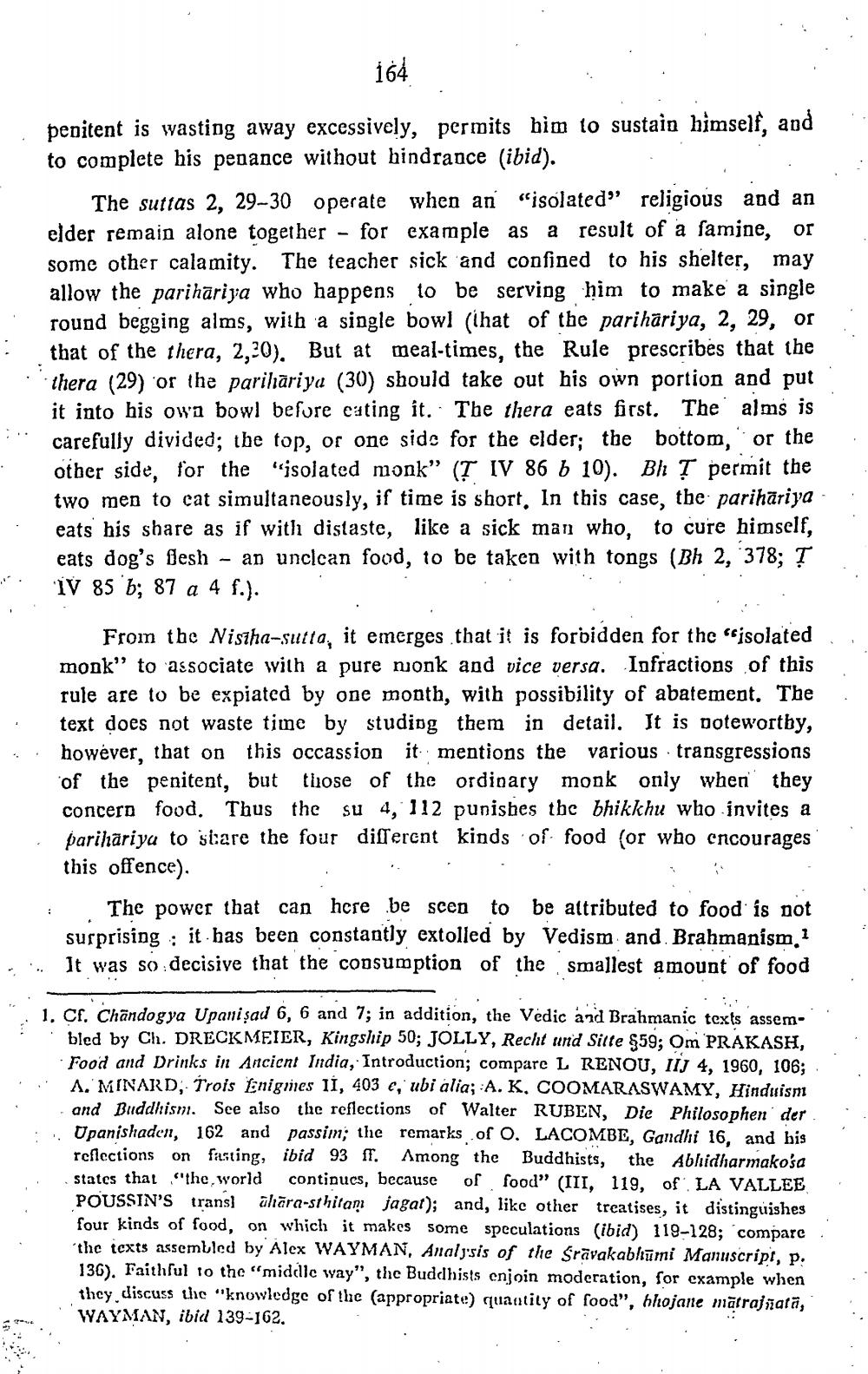________________
164
penitent is wasting away excessively, permits him to sustain himself, and to complete his penance without hindrance (ibid).
The suttas 2, 29-30 operate when an “isolated" religious and an elder remain alone together - for example as a result of a famine, or some other calamity. The teacher sick and confined to his shelter, may allow the parihāriya who happens to be serving him to make a single round begging alms, with a single bowl (that of the parihariya, 2, 29, or that of the thera, 2,20). But at meal-times, the Rule prescribes that the thera (29) or the parilāriya (30) should take out his own portion and put it into his owa bowl before cating it. The thera eats first. The alms is carefully divided; the top, or one side for the elder; the bottom, or the other side, for the “isolated monk" (T IV 86 b 10). Bh Ț permit the two men to cat simultaneously, if time is short. In this case, the parihāriya eats his share as if with distaste, like a sick man who, to cure himself, eats dog's jesh - an unclean food, to be taken with tongs (Bh 2, 378; ? TV 85 b; 87 a 4 f.).
:
From the Nistha-sutta, it emerges that it is forbidden for the isolated monk” to associate with a pure njonk and vice versa. Infractions of this rule are to be expiated by one month, with possibility of abatement. The text does not waste time by studing them in detail. It is noteworthy, however, that on this occassion it mentions the various transgressions of the penitent, but those of the ordinary monk only when they concern food. Thus the su 4, 112 punishes the bhikkhu who invites a parihāriya to stare the four different kinds of food (or who encourages this offence).
The power that can here be scen to be attributed to food is not surprising : it has been constantly extolled by Vedism and. Brahmanism. 1 It was so decisive that the consumption of the smallest amount of food
...
1. Cf. Chandog ya Upanişad 6, 6 and 7; in addition, the Vedic and Brahmanic texts assem
bled by Ch. DRECKMEIER, Kingship 50; JOLLY, Recht und Sitte $59; Om PRAKASH, Food and Drinks in Ancient India, Introduction; compare L RENOU, IIJ 4, 1960, 106: A. MINARD, Trois Enigmes II, 403 e, ubi alia; A. K, COOMARASWAMY, Hinduism and Buddhism. See also the reflections of Walter RUBEN, Die Philosophen der Upanishaden, 162 and passim; the remarks of O. LACOMBE, Gandhi 16, and his reflections on fasting, ibid 93 ff. Among the Buddhists, the Abhidharmakosa states that the world continues, because of food” (III, 119, of LA VALLEE POUSSIN'S trans alara-sthitam jagat); and, like other treatises, it distinguishes four kinds of food, on which it makes some speculations (ibid) 119-128; "compare 'the texts assembled by Alex WAYMAN, Analysis of the Srävakablūmi Manuscript, p. 136). Faithful to the middle way", the Buddhists enjoin moderation, for example when they discuss the "knowledge of the appropriate) quantity of food", bhojane mārajñatā, WAYMAN, ibid 139-162.




